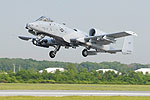Former CSAF: Time to cut the A-10, invest in combat search-and-rescue
 A former top general of the Air Force weighed in on the debate over the future of the A-10, saying it is time to let the venerable jet go and move on to newer jets that can face newer threats.
A former top general of the Air Force weighed in on the debate over the future of the A-10, saying it is time to let the venerable jet go and move on to newer jets that can face newer threats.
“You got to let it go and progress in to the next generation,” said retired Gen. T. Michael Moseley, who served as chief of staff of the Air Force from September 2005 to July 2008.
The Air Force this fall has publicly said it is weighing the possibility of cutting the entire A-10 fleet. The service in a response to Congress about the idea said it would save about $3.5 billion over five years by cutting the fleet and eventually using the F-35 and other fighter and bomber aircraft to fill the close-air support role.
The announcement has met fierce opponents ranging from troops on the ground to senators, with Sen. Kelly Ayotte, R-N.H., placing a hold on the nomination of Deborah Lee James to be the next Air Force secretary.
Moseley compared cutting the A-10s to cuts of other beloved aircraft such as the P-51 Mustang or F-86 Sabre when they became out of date but flying them was “still cool.”
But the time has come to move on to the next generation because “it’s about the survivability and sustainability of the weapons system,” Moseley said Thursday at an Air Force Association event in Arlington, Va.
Moseley said he isn’t worried about the delayed F-35 or “concurrency” issues — setting up training and production on the jet while it is still in testing. Similar issues occurred with other airframes, such as the B-52 Stratofortress. Fifteen bombers were lost during testing, but it has since proved to be a successful and sustainable aircraft, he said.
“We have to be willing to accept risk,” he said.
The Air Force has outlined its top priorities as protecting investment in the F-35, the KC-46A next-generation tanker and the long-range strike bomber. These investments are key, Moseley said. But, if he had one more dollar to invest elsewhere, it would be spend on combat search and rescue.
If the sequester remains in effect, the Air Force could lose funding for its combat rescue helicopter. Without replacements for the aging HH-60G Pave Hawk helicopters, the service’s combat search-and-rescue mission could be in danger of disappearing.
“This is a serious mission area for the Air Force,” Moseley said.